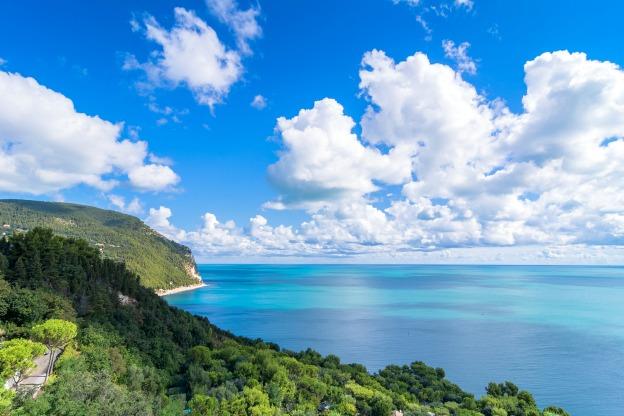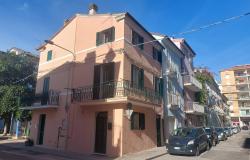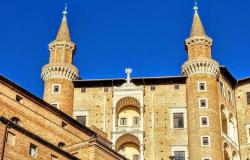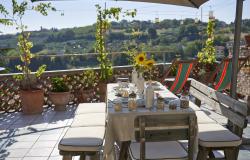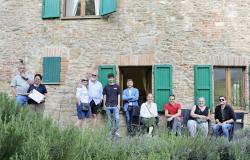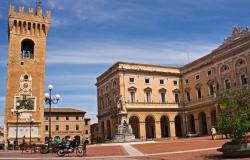Anyone looking to combine an Italian beach vacation with some hiking and cultural activities should head to the Riviera del Conero, a stretch of coast just south of Ancona in Le Marche, dominated by the 572-meter high Mount Conero.
This mountain overlooking the sea is part of the regional park by the same name, Parco del Conero, a 6,000-hectare coastal reserve encompassing part of the territory of Ancona, and the coastal villages of Sirolo, Numana and Camerano.
Attracted by the opportunity to do some excursions on foot as well as spend some relaxing time on the beach, I spent four days in the area. Being so close to the very popular Riviera Romagnola, which tends to become excessively crowded in July and August, I expected to find a packed coast. Instead, I was pleasantly surprised by its quiet undertone; to make things even better, I found the locals to be very friendly and gracious.
My base for the trip was the charming little town of Sirolo, a medieval borgo standing on a hill, with panoramic views of the coast. Sirolo has been dubbed ‘the pearl of the Adriatic’, and a little jewel it is, with its narrow cobblestone vigoli (alleys), the stone arch marking the entrance to the old part of town, the bell tower, and the lovely piazzetta, full of aperitivo hotspots with views of the sea.

[San Michele, the main beach of Sirolo on the Conero Riviera.]
As the avid walker I am, one thing I really enjoyed is that most beaches can only be accessed on foot, by way of trails descending, sometimes steeply, to the shore below. Sirolo’s main beach is San Michele, reachable through a 15-minute walk from the town center, through the woods of the Parco della Repubblica. San Michele is equipped with umbrellas and chairs, but most of the beach is free. There are also a couple of bars. Next to it is the Spiaggia dei Sassi Neri, whose seabed is formed by dark rocks which give the water a specially dark hue; while on the other side is the half-moon shaped Spiaggia Urbani; all three of them have been awarded the Blue Flag, which certifies that the beaches meet the standards of the Foundation for Environmental Education.
San Michele is also the point of departure for a boat excursion to the beach that has become the symbol of the Conero Riviera, the one most often appearing on postcards and brochures: Due Sorelle (Two Sisters), which takes its name from the two white faraglioni, sea stacks, jutting out of the sea at one end of the small cove. Yes, the cove is indeed small, so it does get a little crowded in the summer, but it’s worth spending a few hours there; in addition, the short cruise to reach Due Sorelle gives the chance to better admire this stretch of coast and Monte Conero, which looks impressive from the water.
Another beach I especially liked is Mezzavalle, which you reach after walking down a very steep path from the strada provinciale. It is a very long beach, closed on one side by a natural rocky pier stretching out to sea. If you see people covered in mud, that’s because they’re taking advantage of the large amounts of it found at the foot of the mountain, for a beauty treatment free of charge.
As mentioned above, the Conero Riviera is set within the Conero Park, which features 18 trails, for all ability levels: from short, easy ones to more demanding feats, such as the trail crossing the entire park, which requires a full day hike. I recommend driving to the top of Mount Conero, where several trails depart. These are the best trails that afford views of the coast, the beaches down below and the hilly Marche countryside. In the summer, try to go early; it can get really hot.

[Le Marche countryside and view of Recanati.]
Speaking of the Marche countryside, the rolling hills and sunflowers typical of the region are only a short drive away from the coast. Here, you can find quaint villages full of history and art. My favorite is Recanati, hometown of one of Italy’s greatest poets, Giacomo Leopardi. All around town, on buildings’ walls and doors, you can read excerpts from his beautiful poems; the best way to discover this town is to follow an itinerary in Leopardi’s footsteps, which touches some of the places referenced in his poems and includes a visit to his house, Palazzo Leopardi, with the extensive library where he spent so much of his time. To me, the highlight of the visit was when I reached the so-called “Colle dell’Infinito”, the hilltop that inspired Leopardi’s masterpiece, L’Infinito, where he so eloquently expresses his bittersweet yearning to travel beyond the tight confines of his hometown.
